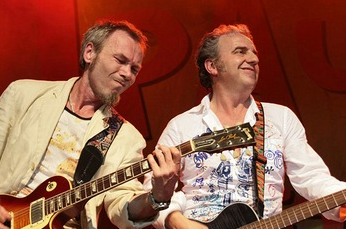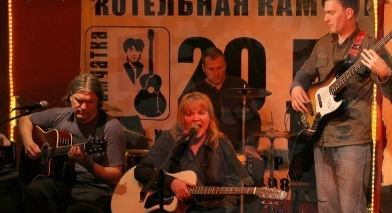Through the Eighties, variety of proficient bands appeared within the Russian provinces. A band with genre of pop rock named Nautilus Pompilius, from a town of Ural Mountain, Sverdlovsk, was one from the provinces. Aside from that band, there's also a vocalist - former vocalist of that band - named Nastia Poleva. After being a vocalist for that band she made her solo career by formed and fronting her own band named Nastia.
Urfin Dzhus, a heavy-metal type of band also was a band from that province, and there are other bands like Chai-f, a distinguished R&B band. Chai-f actually combined the musical parts of West Russian folks music.
From the north of Russia, town named Arkhangel’sk, there's a band named Oblachnyi Krai (Cloudy Region).
Then there's Vostochnyi Sindrom, a band that come from the remote place which was a quintessential band that ever came from Siberia, powerful and uncompromising.
From Novosibirsk, one band called themself as Kalinov Most (Kalinov Bridge) uniquely mix a folk rock music with somekind of their versions of 'nearly' heavy metallic.
 |
| Nautilus Pompilius |
One phenomenon that created the Eighties Soviet rock music explosion potential was the creation among underground rock fans of an unofficial ‘industry’ called ‘magnitizdat.’ Magnitizdat was the personal replica of recordings typically created in clandestine studios. due to this extended network for the dissemination of rock made underground founded on mutual support, cooperation and facilitate, Soviet rock not solely managed to survive its darkest days however eventually emerged ‘victorious.’
 |
| Chai-f |
The importance of Soviet rock music’s historic role within the method of Russia’s democratization lay in liberating national language and discourse from the ideological restraints and propaganda imposed by years of complicity with the necessities of Party-sanctioned political correctness. Rock musicians were the primary Soviet voters to become free in an ‘un-free’ country. They began to talk like free folks, returning to a natural vernacular, so avoiding all types of ideological, ‘new speak’ clichés, and showed the populace the way to speak freely and sincerely, and the way to precise intimate emotions. Their humor and irony hijacked the national discourse, seeping even into the language of tv and therefore the major newspapers. Even ‘babushkas’ within the street were quoting rock songs by the top of the last decade. Towards the top of the Soviet Union and into the Nineties rock musicians emerged because the most uncompromising and revered leaders within the country where the struggle for culture was involved. In 1991, they emerged triumphant, along with the forces of Russian democracy.
 |
| Kalinov Most |
4: 90s to present
With the collapse of the Soviet regime came a rather sudden loss of identity, a private and inventive crisis for several in Russian rock. Rock musicians suddenly lost their role of non secular leadership, and from being wonderful rebels they become easy entertainers, subject to the forces of a free market. now not was it enough to be knowledgeable hero: within the post-perestroika amount the necessity was to be knowledgeable musician. Music and musicians were currently judged, not upon their social relevance and their ability to scandalize authorities, however upon their craftsmanship, their inventive achievements.
 |
| Grazhdanskaia Oborona |
Rock musicians found it exhausting to adapt to the new mafia-capitalist reality. They went looking for new enemies. Fortunately, they weren't that arduous to seek out, as Russia’s newly made, likewise as Westerners profiteering from Russia’s new misery were a simple and engaging target. Thus, some rock musicians went back to the underground, re-establishing their rebellious identity. This was the route taken by Egor Letov of Grazhdanskaia oborona and Sergei Kurekhin, 2 of the foremost illustrious and fashionable leaders of perpetually dissenting Russian rock.
In the early Nineties, it became potential to examine major trends developing in Russian rock once perestroika. There crystallized 3 basic movements: 1) cosmopolitan rock; 2) nationalist rock; and 3) women’s rock.
 |
| Nastia |
The cosmopolitan rock movement has been outlined primarily by the very fact that the musical, poetic and ideological reality of Russian life are principally quite conspicuously absent from its songs. the globe depicted within the songs of cosmopolitan musicians has been completely international and might be found in nearly any trendy country. this can be the globe of ‘the trendy,’ of ‘beautiful’ boys and women, kids who have cash, live quick lives, and travel the globe enjoying luxuries, sex, medication and therefore the nightlife. This music is westernized. it's slightly ironic and detached style of cool rock, with a somewhat monotonous however highly polished and well made sound. This music lacks any reference to Russian traditions, each with regard to Russian pop music and Russian folks music. Highly electronic, the guitar- and keyboard-based sound is paying homage to Western dance genres: house, trance and techno. The songs are sometimes highly danceable.
(... to be continued)